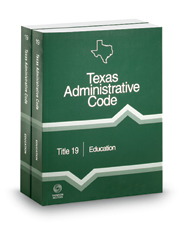
The Texas Administrative Procedure Act requires all administrative rules be compiled and indexed. The Texas Administrative Code (TAC) is a compilation of state agency regulations by agency/subject, after their initial publication in the Texas Register. The TAC is a subject matter arrangement of the administrative rules of the state. It contains 16 titles in non-sequential order. It has the final text of the rules of each agency. Note, it may not contain emergency rules, so be sure to check the Texas Register as well.
The TAC was first published in 1979, and it has been published once a year since 1994. For more information, see the Texas Office of Attorney General's annual Administrative Law Handbook, which provides a helpful overview of the Texas regulatory process.

One should consult the TAC after surveying secondary sources, statutes, and the CFR, particularly if the secondary sources and Texas statutes are unclear regarding Texas regulations.
Electronic Availability
Organization
The hierarchy and terminology of the TAC's organization varies slightly from the CFR:
Title > Part > Chapter > Subchapter > Section/Rule
For example:
Title 7. Banking and Securities
Part 5. Office of Consumer Credit Commissioner
Chapter 86. Retail Creditors
Subchapter A. Registration of Retail Creditors
§ 86.101. Consumer Notifications
Only the title, chapter, and section/rule are referenced in a citation: 7 Tex. Admin. Code § 86.101. (For purposes of searching the TAC on the Secretary of State's website with different fields, 101 alone would be considered the "rule.") If working from a particular citation, it is difficult to browse the TAC on the Secretary of State's website without knowing the part number.
Similar to the CFR, regulations laid out in the TAC provide Tex. Reg. citations that originally published the final rule. For instance, with the above example, its "Source Note" states: "The provisions of this §86.101 adopted to be effective November 9, 2006, 31 TexReg 9017." (Unlike the CFR, there is not a consistent provision of an authority note as well for finding the enabling statute; one has to rely on TexReg instead.) Look for these Tex. Reg. citations if you wish to compile a regulatory history. For assistance in compiling regulatory history, see this guide's page on How to Compile TX Regulatory History.
Ways to Research Regulations
There are several ways to search the TAC.
Currency
An updated print edition is published annually at the beginning of a calendar year. Thus, a 2021 edition of TAC is current as of Dec. 31, 2020. According to the OAG's Texas Administrative Law Handbook, the TAC as published on the Secretary of State website is current each day.
The Secretary of State website is generally the best place to research Texas regulations. This version is updated regularly and is easily searchable. Lexis and Westlaw have the benefit of being annotated. However it can be difficult to navigate to TAC on Lexis and Westlaw. (Ex: Westlaw database is named "Texas Regulations" rather than TAC.) And the citator flags of new proposed and emergency regulations from the Texas Register aren't kept up sufficiently up to date. I.e., not putting up flags as soon as proposed and not taking down flags as soon needed. Westlaw does provide a "Compare Versions" feature--click button top right of individual reg--with coverage start date of 1/1/2018.
The print version is another good resource because of its index; however, the index is only updated annually.
| Federal | Texas |
|
Titles > Chapters > Parts > Sections |
Title > Part > Chapter > Subchapter > Section/Rule Only the title, chapter, and section/rule are referenced in a citation. Ex: 7 Tex. Admin. Code § 86.101 Title 7. Banking and Securities Part 5. Office of Consumer Credit Commissioner Chapter 86. Retail Creditors Subchapter A. Registration of Retail Creditors § 86.101. Consumer Notifications (For purposes of searching the TAC on the Secretary of State's website with different fields, 101 alone would be considered the "rule.") If working from a particular citation, it is difficult to browse the TAC on the Secretary of State's website without knowing the part number. |
